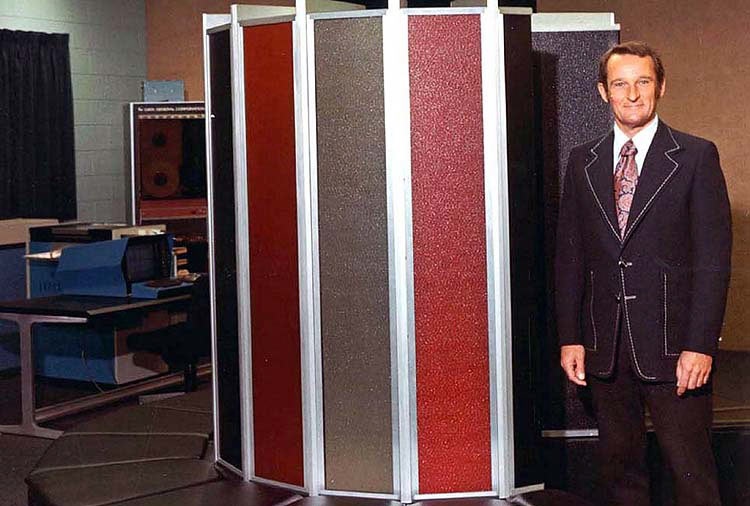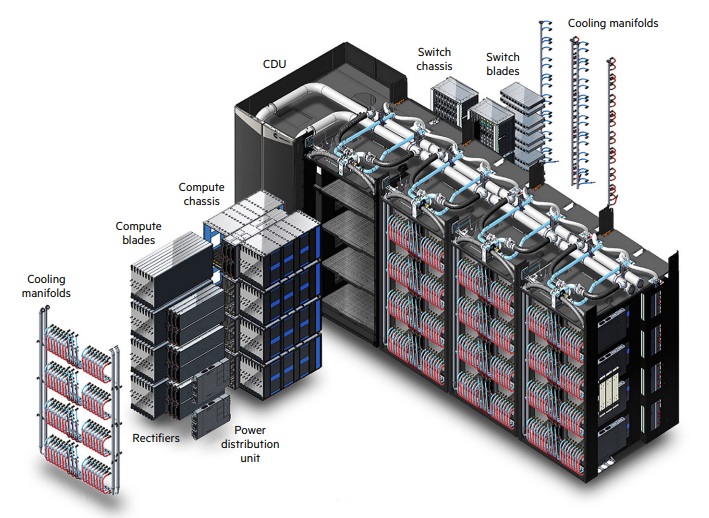The HPC community, ever-affectionate toward Cray and its eponymous founder, can breathe a (virtual) sigh of relief. The Cray brand will live on, encompassing the pinnacle of HPE’s HPC portfolio.
After announcing its intention to acquire Cray last May (2019), HPE avowed that it would honor the Cray brand and lineage, but we’ve seen other legacy brands be phased out after acquisition, despite similar assurances.

Now, ten months since the $1.4 billion deal closed, the portfolio merger is complete, with the Cray name retained as the focus of leading-edge HPC technology within HPE. Parts of the blended portfolio were announced in March, but now there are official product names to share.
HPE Cray supercomputers are available in two configurations: HPE Cray EX liquid-cooled and the HPE Cray air-cooled infrastructures.
At the apex of HPE’s supercomputing portfolio is the HPE Cray EX supercomputer, what was previously the Shasta liquid-cooled system. The ‘EX,’ we gather, is a nod to the machine’s starring role in the U.S. exascale computing program. And perhaps it also hearkens to previous Cray systems: the XC, XT, XK, X1, and XD.
The building block of the HPE Cray EX supercomputer is the liquid cooled cabinet, a sealed unit that uses closed-loop cooling technology. Each EX cabinet holds eight compute chassis and a total of 64 blades with eight Slingshot injection ports per blade. Each blade supports four dual-CPU nodes for a total of 512 processors per cabinet. The entire AMD second-generation “Rome” Epyc 7002 series processor stack is supported.

The HPE Cray EX supercomputer underpins U.S. plans to stand up three exascale machines in the 2021-2023 timeframe: Aurora (with prime contractor Intel) at Argonne National Laboratory, Frontier (with AMD) at Oak Ridge National Laboratory and El Capitan (with AMD) at Lawrence Livermore National Lab.
The HPE Cray supercomputer (sans EX) combines the Cray Shasta air-cooled cabinetry with the HPE Apollo 2000 Gen10 Plus chassis, powered by dual-socket AMD second-generation Epyc “Rome” 7002 series processors. There are one or two Slingshot injection ports per node, offering 200 Gbps via dual-injection. With the air-cooled infrastructure, HPE brings the benefits of high-end HPC for broader enterprise use. “Functionally, the processor equivalent versions of the liquid-cooled and air-cooled solutions are identical with the same interconnect and software support,” said Brandon Draeger, head of compute product marketing, Hewlett Packard Enterprise.
Initial HPE Cray supercomputer blades will support AMD Eypc Rome 7002 CPUs, but future implementations will support other processing architectures. Flexibility and support for multiple compute platforms were founding design principles of Shasta, which HPE is carrying forward. HPE also said the Shasta air-cooled system is the first product to be integrated into the HPE Cray line, but that more integrations are in the works.
“HPE Cray supercomputers are based on an array of HPE and Cray technologies (including a few from Hewlett Packard Labs),” said Peter Ungaro, senior vice president and general manager of HPC and mission critical solutions, Hewlett Packard Enterprise, and formerly Cray CEO. “Those technologies include new capabilities from Cray’s Shasta architecture which are being developed for the first three U.S. exascale systems. As these new capabilities are productized, they will appear first in the HPE Cray supercomputing line and then will be supported more broadly across various HPE products and offerings.”
“We determined that today’s HPC users increasingly want to run a mix of workflows (for example, simulation, analytics, and AI) on one system that can handle them all simultaneously,” said Draeger, who also came to HPE as part of the Cray acquisition. “The era of addressing different workloads with different systems was rapidly ending, and our goal quickly became to build a flexible, heterogeneous architecture. One that handles the increasingly data-centric workloads needs to run to answer today’s most important questions for research and commercial entities.”
Other naming conventions announced were the HPE Cray Software Stack, and the Cray ClusterStor storage line, which includes the Cray ClusterStor E1000 product.
Slingshot, the advanced Ethernet networking technology that Cray developed under the direction of CTO Steve Scott (now at Microsoft), is simply known as HPE Slingshot.

Notably, Fujitsu A64FX-based systems will not go forward as part of the Cray family. The A64FX Arm CPU will be supported in the new Apollo 80 server, and all the A64FX system wins that Cray announced in November as CS500s have transitioned into Apollo 80 systems. The Apollo 80 chassis is configured with up to four blades, with each blade housing two single-socket A64FX Arm servers. HPE Apollo 80 customers include Los Alamos National Laboratory, Oak Ridge National Laboratory, RIKEN Center for Computational Science, Stony Brook University, University of Bristol, Leibniz Supercomputing Centre (LRZ), and — the latest to be announced — the Center for Development of Advanced Computing (CDAC).
Based on prior conversations I’ve had with HPE execs, I think HPE is planning to support Arm in its HPE Cray (formerly “Shasta”) line, but the A64FX chip does not support PCIe gen 4, which is required for Slingshot compatibility.
HPE told us that the CS500 products are at the end of their lifecycle. “Existing systems out in the field will be supported per terms of various contracts, but the product line is discontinued and customers have been notified,” an HPE rep shared, noting that the HPE Apollo line offers similar functionality.
The Cray XC line has also reached end-of-life, including the XC50, which supported Marvell’s ThunderX2 Arm processor.
“The integration of Cray into Hewlett Packard Enterprise is effectively complete for our people, our critical business systems, our roadmaps, and our brands. It’s an integration milestone we call Business Day One,” said Ungaro in a blog post.
“Thanks to everyone in the community! This reveal is the culmination of 6+ months of brand research with you – our users and fans – in arriving here,” tweeted Draeger. “We acknowledge the legacies we carry forward and knew we had to get it right. Stay tuned for more things to come from HPE Cray!”
Reached for comment, HPC analyst Addison Snell, CEO of Intersect360 Research, commended the departure from traditional marketing orthodoxy.
“The decision to keep the Cray brand in association with its supercomputers is a relief to countless fans, but that doesn’t mean it was an easy decision,” said Snell. “HPE is a strong brand, and it is good at branding, and normal branding rules would dictate maintaining long-term branding consistency by downplaying Cray and promoting HPE. That answer would receive an A on most MBA marketing exams. Knowing when to make an exception that breaks the rule is what earns an A+.
“The Cray brand is one of those exceptions, a single word that by itself connotes not only a specific product, but also an emotion, a passion among a set of devoted followers. This rare kind of trademark is what Saatchi & Saatchi CEO Kevin Roberts called a ‘lovemark.’ This is a brand that should be embraced and cultivated, not abandoned, even when it breaks the branding rules.
“Beyond that, I admit I like that it continues to honor the memory of the man, Seymour Cray.”
HPE Cray supercomputers are available now (as of August 3).


























































